Tribal Profiles
- Tribal Profiles
- Southwest Region
- Bidii Baby Foods
- Bishop Paiute Tribe
- Diné Native Plants Program
- Fort McDowell Yavapai Nation
- Hopi Earth Day
- ITEP’s SW Tribal Climate Change Project
- ITEP’s Academic Year Internship Program
- Jemez Pueblo Renewable Energy
- La Jolla Band of Luiseño Indians
- Mescalero Apache Tribe
- Native Seeds/Search
- Navajo Nation Dune Study
- North Leupp Family Farms
- Pueblo of Tesuque
- Pueblo de San Ildefonso Climate Action Plan
- Santa Ynez Band of Chumash Indians
- Tohono O’odham
- Ute Mountain Ute
- Wind River
- Tribal Profiles
- Southwest Region
- Bidii Baby Foods
- Bishop Paiute Tribe
- Diné Native Plants Program
- Fort McDowell Yavapai Nation
- Hopi Earth Day
- ITEP’s SW Tribal Climate Change Project
- ITEP’s Academic Year Internship Program
- Jemez Pueblo Renewable Energy
- La Jolla Band of Luiseño Indians
- Mescalero Apache Tribe
- Native Seeds/Search
- Navajo Nation Dune Study
- North Leupp Family Farms
- Pueblo of Tesuque
- Pueblo de San Ildefonso Climate Action Plan
- Santa Ynez Band of Chumash Indians
- Tohono O’odham
- Ute Mountain Ute
- Wind River
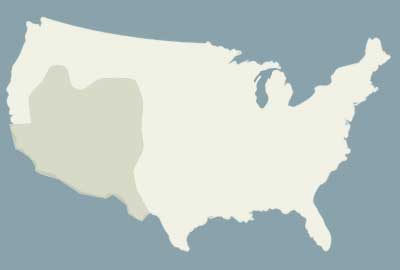
Wind River Indigenous Youth Culture and Climate Day Camps
Click HERE for PDF version.
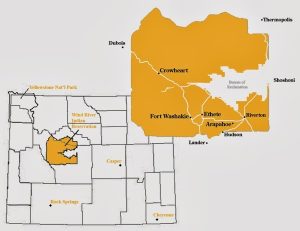
The Wind River Reservation is 2.5 million acres of wild landscape, with a 138,000-acre roadless area home to buffalo, wolves, and other wildlife. But climate change is putting pressures on habitats, water availability, and foraging. In recent years, Wind River has seen rising temperatures and a 25% decrease in snowpack, and on top of that, there’s an acid rain problem in the area due to natural gas extraction and processing. Meanwhile, in the isolated mountain country of the Wind River Reservation, Big Wind River flows and land awaits for buffalo to roam. School children run about seasoning buffalo burgers, trying on furs, holding skulls, and learning the traditional languages of their ancestors – the Shoshone and Arapaho. Facilitating this outdoor learning and play are the Wind River Indigenous Youth Culture and Climate Day Camps, whose focus is reconnecting Indigenous Youth to the land and the teachings of their Elders. This reconnection to traditional Shoshone and Arapaho teachings, when paired with modern science, is key to combatting climate impacts to the land.
“Bringing young people and our Elders together to reinstill our respect for nature is the key to our future.“. – Wes Martel, Greater Yellowstone Coalition
Janna Black had just moved from Washington to Wyoming and started graduate school at the University of Wyoming. She knew she wanted to work with local Tribal communities for her master’s thesis, and was soon introduced to Wes Martel, Senior Wind River Conservation Associate with the Greater Yellowstone Coalition (GYC) and former Councilman on the Eastern Shoshone Business Council. Wes had the idea to bring students and young people out to camp on newly acquired land and included Janna to help document the process and organize before and during the camps. Janna also supplemented their plans with academic research and Indigenous teachings from across North America as part of her master’s thesis.
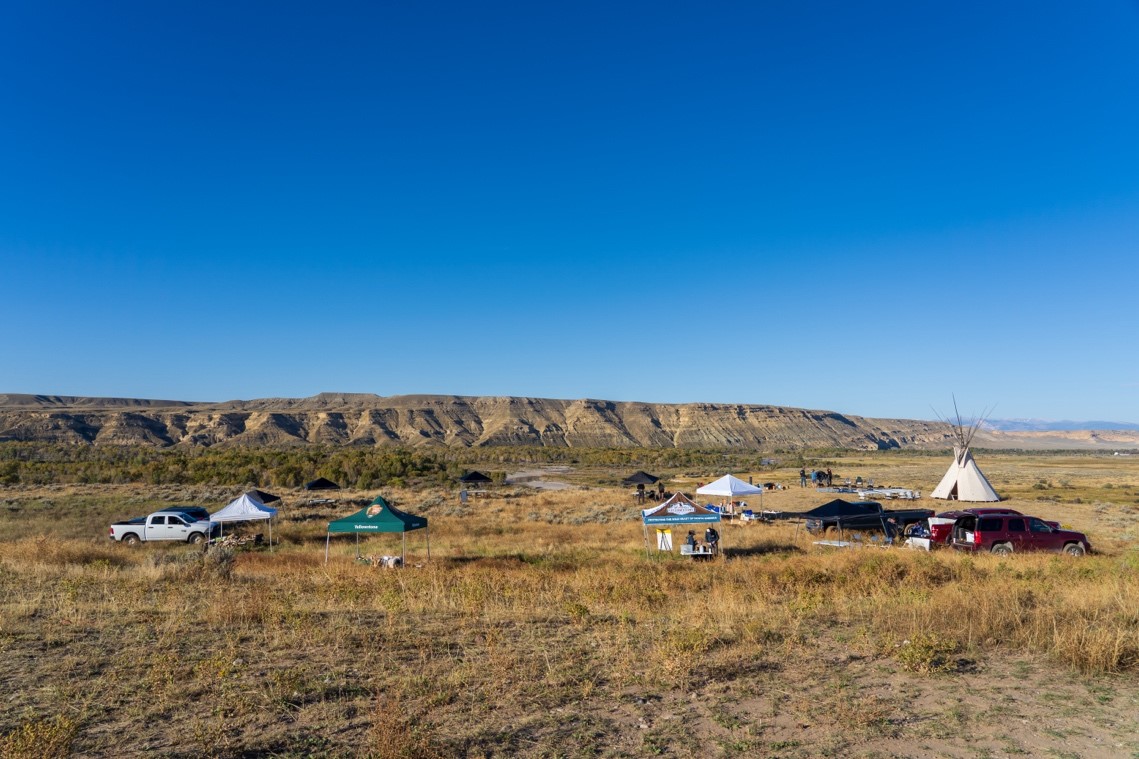
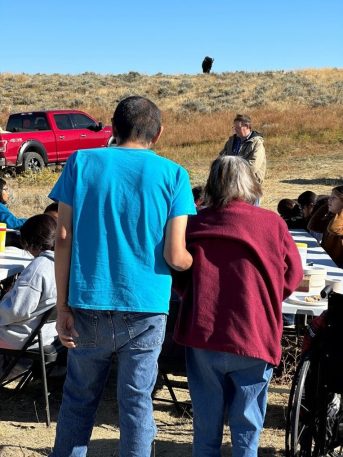
In late September 2023, after months of planning, school board meetings, and presenting the idea to many entities, including the Inter-Tribal business council, students from Wyoming Indian Schools attended the first ever Wind River Indigenous Youth Culture and Climate Day Camp. Elementary school students came for one day, middle schoolers the next, and high school upperclassmen the last.
Each day camp began with a prayer from a Shoshone or Arapaho Elder. On the first day as the group assembled for a Shoshone Elder, a very unexpected, yet very welcome guest arrived to join us in prayer. Our relative joined us to let us know he was with us and supported what we were doing. The Elder paused briefly, as everyone realized that a buffalo had joined to listen to the prayer from the hilltop. The Elder said that the buffalo recognized the Shoshone language, and she continued the prayer. As the Elder continued, the buffalo stayed on the hilltop for the remainder of the prayer, and as the Elder finished, the buffalo moseyed down the hillside and into the ravine, towards the river. The buffalo was remarkably close to the children, but they sat still in awe, whispering their amazement. Wes told the children, “He’s here to let us know that he’s with us. He supports what we’re doing. We’re the ones with a voice. We have to talk for him.” One student, when reflecting on what they learned at the camp, wrote “I learned that the buffalo comes when you pray.” Everyone – children, Elders, and facilitators – agreed it was a good blessing for the start of the day camps.
Throughout the day, students were split into small groups and spent time exploring language, buffalo, wildlife, cooking, culture, conservation, climate change, and their local environment at booths hosted by Wind River residents, Shoshone and Arapaho Tribal Elders, representatives from federal agencies, and field scientists.
The US Fish and Wildlife Service brought an assortment of furs and bones from local animals that students were encouraged to touch and try on, and hold and feel the antlers, skulls, and other bones. Later they moved on to the Shoshone and Arapaho language and culture booths, where they were taught bits of the language and some traditional uses of buffalo. Grilled buffalo burgers gave students hands-on experience cooking traditional foods while they further learned the importance of using every part of the buffalo. Students used a mortar and pestle to blend spices and seasonings for the buffalo patties. Other booths showcased small science experiments, emphasizing water and resource management and the importance of conservation practices in the region.
While the day camps connected students to their Elders and the respective Shoshone and Arapaho cultures, all while providing them with hands-on learning activities in their local environment, it was crucial that the students spent time outside, learning and playing on Traditional Lands. Students saw the impacts of climate change on the land first-hand through an interactive teaching on the uses of sagebrush led by the National Park Service, and the stressors it is currently facing due to water availability, heat, and wildfires. While younger students reflected on climate change and the role of conservation on protecting species like sagebrush, older students considered the possibility of a career with these federal agencies, back on or near the Wind River Reservation – exactly what Wes hoped they would do
“All we’re trying to do is strengthen our families and our communities. That’s all we’re trying to do.” – Wes Martel, Greater Yellowstone Coalition
The best way to combat the climate impacts Wind River is facing, Wes Martel says, is to use good science and good technical information, but also to use teachings from Elders. The day camps not only hope to connect Wind River Indigenous Youth to the land, but to get them to start thinking of careers back on the Reservation. Connecting with the University of Wyoming has been essential in dispelling anxieties students on the Wind River Reservation have about college. Not only do the day camp hosts hope to encourage Wind River high school students to think about getting a degree in STEM, but they hope to create connections for internships and fellowships back on the Reservation for students in college.
Wes hopes that the camps not only connect Wind River Youth back to the land, but also gets them to understand their Tribal Sovereignty and Wind River governance. He says, “It’s just so important, just to know our system, know our government, connect our Elders with our young people.” The Reservation is shared by two Tribes, the Eastern Shoshone and Northern Arapaho, and has no constitution, which makes its governance structure unique. When students consider returning to the Wind River Reservation for work after college graduation, he hopes that they consider their Tribal Governance in their careers too, regardless of the field they’re in.
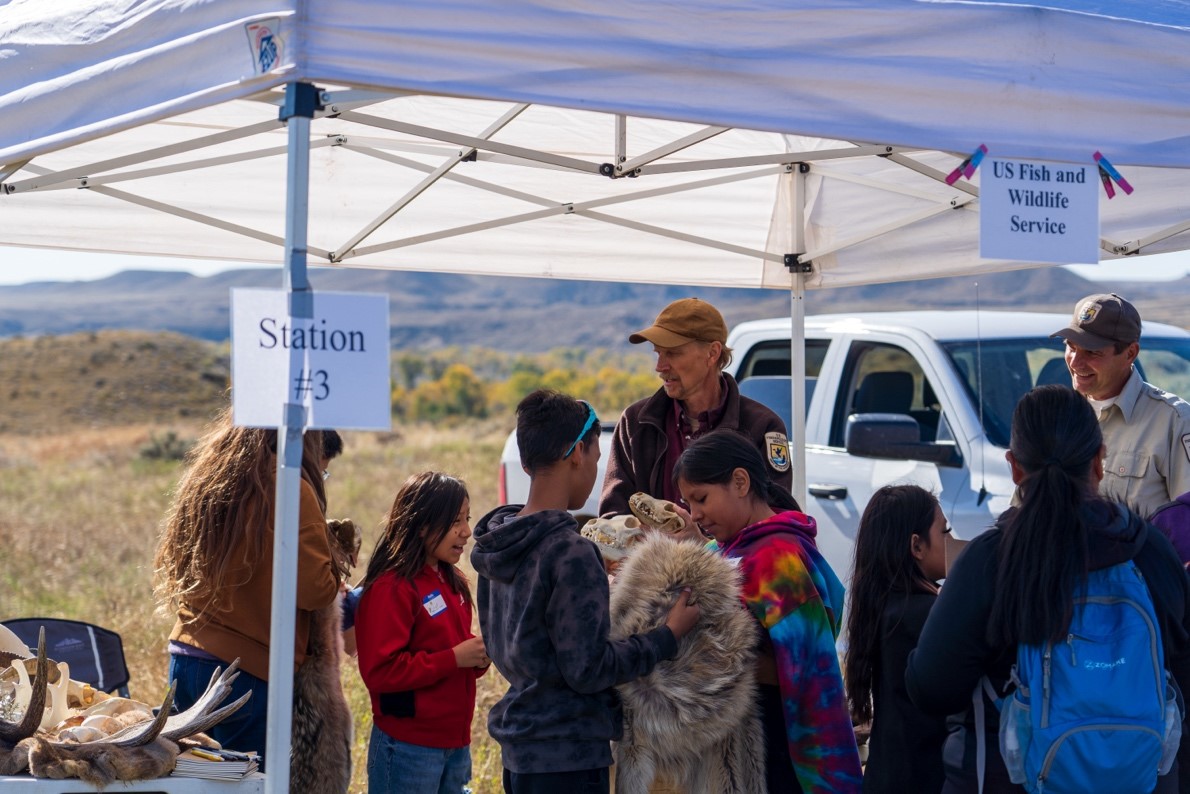
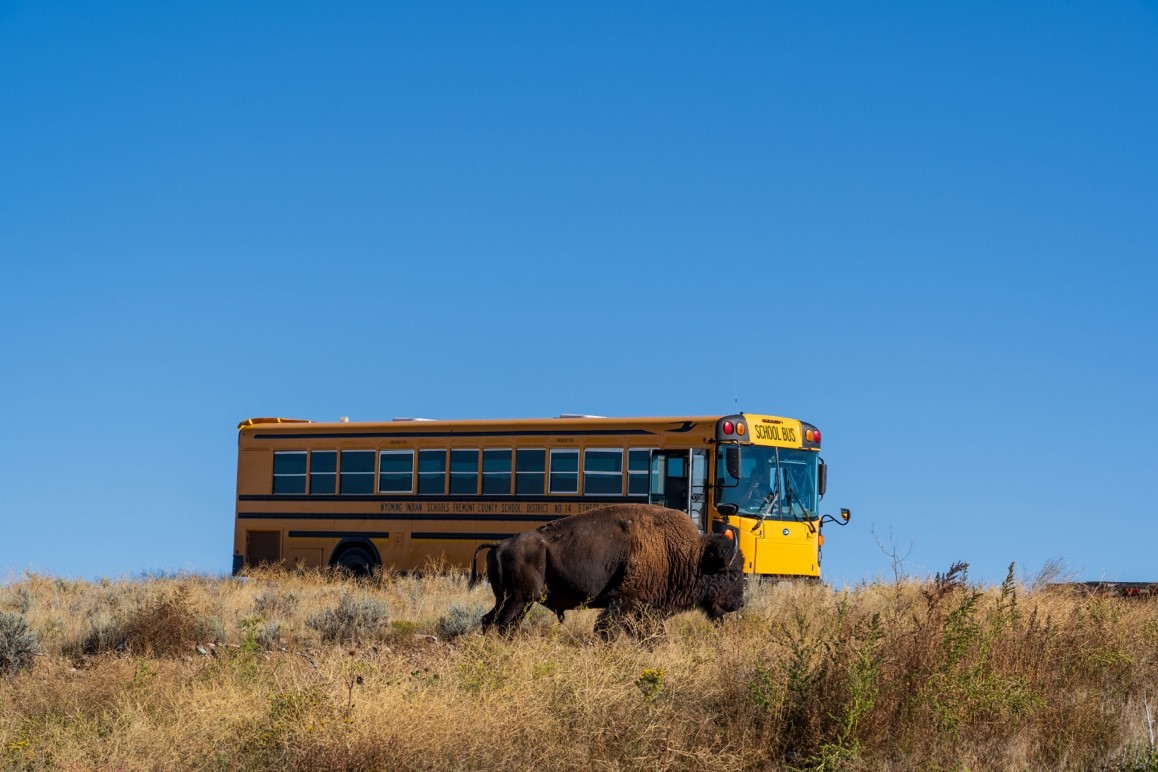
This year (2024) the Wind River Indigenous Youth Culture and Climate Day Camps are being held in late June with summer school students. While the campers and facilitators have been fortunate to hold camp in such beautiful weather so far, they hope their exclusivity to the summer months won’t be the case for much longer as eventually these day camps will be held year-round. In the dead of winter, when the area has 5 or 6 feet of snow on the ground, they want to get kids out there, learning how their ancestors survived in the cold. They want students to experience the four seasons, and to understand how past Shoshone and Arapahoe generations lived on the land year-round. To the Shoshone and Arapaho, the the Four Directions are connected to the the solstice, so getting students outside year-round is essential for reconnecting to their beliefs and value system.
In future camps, facilitators also hope to hold space for artistic expression, movement, and connecting with the land. They’re looking for feedback from the Wind River community on what they think should be integrated into the camps. Connecting the community to these camps is part of Wes’ plan to strengthen families on the Wind River Reservation. He plans to not only get feedback from family members on how to incorporate other teachings into the camps, but to introduce them to the technical science that they’re incorporating at the camps as well. Wes hopes to extend the camps to activities at night at the schools when teachers, students, and their families can all be present.
Although Janna has since graduated, she continues to volunteer at the day camps. The booklet she compiled for her master’s thesis not only serves as a retelling of how the Wind River Indigenous Youth Culture and Climate Day Camps came to be, but as a guide for other Indigenous communities and families to adopt Traditional Teachings and Elder Connections into their curriculum. She hopes it will assist other Tribal communities with engaging their youth in their respective cultures and local environments. Janna Black’s guide is available online.
Resources and References
- Black, Janna. (2024). Strengthening Sense of Place Rooted in Culture through Intergenerational Land-Based Learning. Available online from
https://online.fliphtml5.com/qegyo/molx/#p=1 [accessed June 10, 2024].
This profile was developed in 2024 by Taryn Bell, Institute for Tribal Environmental Professionals, Northern Arizona University, with financial support from the Bureau of Indian Affairs. The profile is available on the Tribal Wellbeing for Seven Generations Program website: https://itep.nau.edu/twsgp/tribes/. The tribal profiles featured on the website are intended to be a pathway to increasing knowledge among tribal and non-tribal organizations interested in learning about climate change mitigation and adaptation efforts.
Special thanks to Janna Black and Wes Martel for their assistance in developing this profile.
CONNECT WITH US
Nikki Cooley
Co-Director
Nikki.Cooley@nau.edu
Karen Cozzetto
Manager
Karen.Cozzetto@nau.edu
Your tax deductible donation supports ITEP’s programming efforts.
Please contact us if you would like to contribute to our endowment or for any additional information regarding donations.

